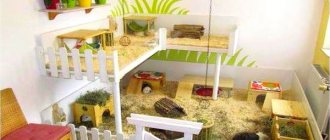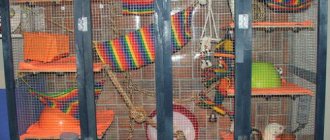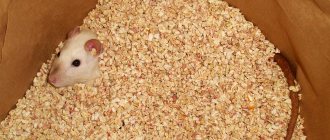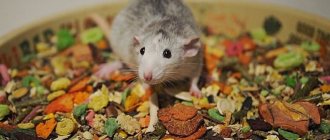Sly beady eyes, small neat ears, a funny elongated mustachioed muzzle, a long catchy tail and an extraordinary mind. This is a decorative rat. And so you succumbed to the charm of this cute rodent and decided to have him as a pet. But where to put the little animal?
It is important to approach the choice of a home for a rat with maximum responsibility and arrange it according to all the rules. After all, only then will the pet feel comfortable and please its owner. Find out what the right cages for decorative rats should be like, how to arrange a rat’s home, and how to care for it.
Which filler is best to use?
The filler is designed to make your little friend feel comfortable.
The rat should have a place where it can nest, sleep and do whatever it wants. This is where the quality of the filler becomes important. You wouldn't want your precious pet's comfort to be compromised. The best thing you can do for your rat is to mimic its natural habitat. Rats typically build nests indoors in the wild. Thus, they feel safe in such places. When you provide your rat with soft litter where they can move freely, nest and play, you ensure that they feel at home in the cage. The filler should also be equipped with liquid absorption and odor control functions. With all the necessary features and conditions, the rat cage becomes more comfortable for everyone.
It is in your pet rat's best interest to use litter that is as dust-free as possible. A good choice is CareFresh litter, which is great for rat cages and consists of paper materials. It hides the smell well, absorbs any liquids and does not harm the rat. However, its disadvantage is that the filler will have to be changed quite often.
Nutrition and prohibited foods
It is important to know exactly what to feed your dumbo rat. Proper nutrition will help keep your pet active and extend its life.
First of all, you need to carefully ensure that the rat always has clean water. The drink should be changed daily.
The diet of a Dumbo rat should be rich in nutrients and vitamins. It is useful to feed them with grain: oats, wheat, barley. To diversify the diet, you can add boiled liver to animal food: kidneys, liver, heart. Rodents should be given nuts to wear down their teeth.
Dumbo loves fresh apples, peaches, ripe bananas, and cherries. But you need to be careful with dried fruits: they contain a high sugar content.
Knowing what dumbo rats eat, you should exclude the following foods from their diet:
- fatty fried foods
- raw potatoes
- radish, turnip, radish
- cabbage
- artichokes
- legumes
- citrus
- mushrooms
- dairy
- sweets
Many people are interested in the question of whether it is possible to feed a dumbo rat with sausage or meat. The answer is clear: you can’t. Sausages contain a large amount of preservatives, spices and salt, which are dangerous for rodents. The same applies to meats that are high in fat.
Small rodents are fed no more than twice a day, adult Dumbo rats more often: three to four.
How to choose a cage for rodents
Selection criteria are divided into general for all rodents, as well as specific for animals of each individual species. Below are general aspects, and a description of the features in the rating.
Size
A rodent, small or large, must move freely, run, jump, and play. And if there are several individuals, each will need its own territory. In addition, the total volume should allow for accessories to be placed. Too close a living environment causes depression and a sedentary lifestyle. And too large spaces increase the risk of injury.
Recommendations from experts on minimum areas vary greatly, but are approximately as follows:
- for guinea pigs - the optimal cage height is 40 cm, width 60;
- for rats and chinchillas – width 35 cm, length 55, height 80;
- for hamsters - for dwarf hamsters the bottom is at least 30x60 cm, for Syrian hamsters 30x40, since they are less mobile;
- for mice - for small ones 25x15 cm, for large breeds add ten centimeters;
- for gerbils – 50x25 cm, height 70.
If the cage is multi-story, with transitions, this increases the usable space, so you can deviate from the parameters.
According to buyers, expert advice deserves attention, but in practice, finding cells that meet the requirements is not so simple; it is easier to rely on the manufacturer’s instructions and common sense.
The best manufacturers
Ferplast (Italy), Savic (Belgium), Inter Zoo (Poland), Zoomark (Russia) - they have been making animal cages for many years, using the best materials, and carefully thinking through the design.
Material
Types used: metal, wood, plastic and glass. The best solution is to combine textures. The most common combination: metal frame, plastic tray. Or a glass bottom with a metal mesh on top.
Metal rods without painting are preferable for the health of rodents, since they will taste them often. Wooden elements must be treated with a moisture-proofing agent. And the plastic is non-toxic, easy to wash, and dries quickly.
Distance between rods
Depends on the size of the rodent. Approximate parameters:
- for guinea pigs and chinchillas – 15-25 mm;
- for rats – 17 mm;
- for hamsters – 7-10 mm;
- for mice and gerbils – 7-8 mm.
Doors
Their reliability determines how often you will have to look for your pet throughout the house. Rodents are adept at opening “closed doors” as part of their natural instinctive movement in search of food; a simple hook gives them too easily.
Accessories
The richer the set of accessories, the more varied the rodents’ pastime, the more interesting it is to watch them. The mandatory minimum is a drinking bowl and a feeder, the rest is optional. The wheel provides the greatest physical activity
It is important that its diameter is slightly larger than the length of the animal’s body
Transportation
Depending on how often you plan to move the cage, you need to pay attention to the presence of wheels, a carrying handle, and estimate the weight of the product
Care
The more accessories, the more troublesome cleaning is. Too many houses, tunnels and wheels become a problem, each of the components takes time.
It is easiest to clean cages with a simple design, those with large distances between floors and wide doors. The removable roof and retractable bottom make maintenance much easier.
Features of a cage for domestic rats
For the animal, it is advisable to arrange a cage in which the rat will be kept. The main task in organizing a cage for a decorative rat is to make it large, comfortable and safe for the animal to live in. There are families who immediately let the animal roam freely throughout the property. This is undoubtedly a plus for his freedom, but a decorative rat must have its own personal and safe space.
What should a cell be like?
It is advisable to make the rat’s home where no one and nothing will disturb it. It should be noted that the decorative rat is very concerned about cleanliness, so you need to pay special attention to the tray in it. It is advisable to choose a tall tray, at least 10 cm. Then, during active games in the cage, the filler with which the tray is covered will be inside and will not fly apart.
It is not advisable to use metal and wooden pallets - they are most susceptible to getting wet or rusting, rodents easily deform them, i.e. they are not durable. It is more practical to use pallets made of durable plastic. They are easy to remove odor and wash. When purchasing, you need to pay attention to the quality of the plastic so that there is no strong chemical smell, chips or cracks.
From the above, it is clear that the ideal option for a decorative rat is a large cage with a plastic tray and strong rods. In this case, it is very important to take into account how many animals the cage is purchased for.
What size should the cage be?
The minimum cage size when placing one or two animals should be 60x40 cm in size and at least 50 cm in height. If a larger number of rodents will live in the cage, then you should choose a cage with a large tray and higher in height - up to 80 cm.
The choice of rat cage also depends on the gender and sometimes the breed of the pet. Therefore, it is better to distribute individuals of the same sex for housing, boys behave calmer, and for their maintenance it is better to choose a model with a wider tray and horizontal, but girls behave more active and agile, they like to climb high, so a cage with two tiers and height 60 cm.
The size of the cage for a rat should be such that it can easily stand in it without touching its head to the ceiling, can easily stretch out and lie down freely.
The choice of cage is also influenced by the size of the room itself where the cage is located. If a large cage does not fit on your territory, then it is not advisable to buy animals.
With good maintenance and proper feeding, baby rats grow and develop very quickly, which means that a small cage will not be relevant, the animal will be inactive, which leads to lethargy and can cause various diseases. Also, a small cage will irritate the little rat and affect its character.
Options for cage bars
There are several options for metal rods. The difference is that painted rods are more practical , while galvanized rods are susceptible to corrosion. The rods must be rounded and welded very firmly, in order to ensure safety for the life of the rat and its babies.
Some breeders use collapsible and foldable cages to keep their pets - such cages are more comfortable to use and transport, and take up very little space during storage - if there is a need for the rats to periodically live in another place.
Why did they plant the pig?
The owner of one of the Chelyabinsk pet stores, Elena, admits that over the years that she has been selling guinea pigs, hamsters and mice, she has never gotten used to these animals. The passing year of the pig has increased the demand for guinea pigs. But, the woman says, she could still give them to the buyer with her bare hands when she sold them. Mice and rats are a different story. “I asked everyone who said that they were giving a guinea pig: why did you give people a pig? - the woman thinks. “Now I understand: okay, a pig, getting a rat will be much more offensive.” Elena admits: after having to deal with rats, showing customers how to feed and clean the cage, she feels like her whole body is dirty, fleas are crawling all over it, and out of disgust she wants to dive headfirst into the bath.
The seller recalls how she was given a live rabbit for New Year's 1999. This was also a symbol of the year according to the eastern calendar. The rabbit was small and cute, but literally after a few months he turned into a huge representative of the hare family. The small decorative rodent turned out to be... an ordinary rabbit. Somehow the woman managed to arrange a living gift for her friends in the village. She only asked not to tell her when Fedya would be eaten.
Dumbo rat breeding
Breeding Dumbo rats is a simple process
There is nothing difficult about breeding dumbo rats. These animals reproduce quickly and do not experience problems in bearing and giving birth to offspring .
How to determine gender
Males can be distinguished from females by their enlarged testicles, which are clearly visible already at the age of 2–3 weeks. In female decorative rats, the rudiments of nipples are observed during this period of life.
Mating
Sexual maturity occurs early - at the age of 5–6 weeks. But individuals from 8 to 10 weeks are recommended for mating. In order to get offspring, it is enough to leave the male and female in the same cage for a couple of days. But you need to understand that fertilization is possible only if the female is in heat. It occurs regularly at intervals of 4–7 days.
Pregnancy
From the moment of fertilization to the birth of rat pups, no more than 23 days pass. On average, birth occurs between 21 and 23 days. The female's pregnancy becomes noticeable starting from the second week after fertilization. The animal’s physique plays a big role in the appearance of the first signs. If the female is thin, the rounded tummy will be noticeable faster than in a fat and large rat.
A litter can contain from 8 to 15 pups. During pregnancy, the female needs increased and nutritious nutrition. Bloody discharge and the female's desire for privacy will indicate the approaching birth . Often the dumbo rat begins to prepare its nest: it cleans and arranges it. Childbirth lasts no more than 3 hours.
How to care for newborn rat pups
The female Dumbo takes good care of her offspring. During this period, the owner must follow several rules:
- do not pick up baby rats;
- take care of the cleanliness of the cell;
- provide the mother with good nutrition.
Rats can be handled once they are 14–15 days old.
Vintage basket
Here we are dealing with a representative design in the style of modern rural fashion. Best suited for lovers of cycling or short distance travel on scooters. The basket itself is woven from flexible willow and equipped with an openwork wire lid, which prevents the cat from wanting to get out while moving. At the first glance at such a carrier, one is reminded of idyllic pictures from centuries ago, when food from the market was transported in a similar way on bicycles. The entire structure is conveniently attached to the steering wheel using leather straps and does not require much time for preparation.
The advantage of the option under consideration is, of course, its original design and originality. The downside is limited functionality. Although, if desired, the basket can be used for its intended purpose.
Price – 1,128 – 1,708 rubles.
An option for real needlewomen - a closed knitted hammock
Knitted houses for rats, created by yourself, are an option that will allow you to create colorful and comfortable housing for your pet. A knitted house is called a hammock. The hammock can be closed or open.
The principle of creating a closed hammock:
- The easiest way to create a design is with a hook. It is advisable to use acrylic threads for knitting.
- Knitting starts from the bottom. You can make the bottom double and put a piece of plywood in the resulting pocket.
- It is possible to knit in the round or knit individual parts and then sew them. The simplest option is circular knitting.
- It is worth casting on five air loops and closing them in a circle. Next, knit several rows adding 1 loop to each row. The number of such rows is determined by the desired size. This knitting will allow you to form the floor of the house.
- After making the bottom of the house, you can start knitting the walls. Rows are knitted without additions. Their number will determine the lifting height for the move.
- You need to count 10 loops and do not knit them until the opening is formed.
- Then the unknitted loops are closed using a chain of air loops.
- The roof is knitted in the same way as the floor. Only instead of adding loops in each row, a decrease is made.
In order not to think about how to shape the product using various frames, you can simply hang the hammock at several points. The house will stretch and take on the desired shape.
Single-tier rabbit cage, first steps - frame
If you have a drawing and the desire to build cages for breeding rabbits, it will not be at all difficult.
First, a frame is formed:
- Wooden beams are prepared in advance and treated with an antiseptic composition in order to subsequently avoid rotting of the material and the appearance of harmful microorganisms in it.
- The timber is used to assemble the frame of the future cage. 4 beams of 1.5 meters each, 4 – 55 cm and 4 – 70 cm are cut from the workpiece. You can replace 4 beams of 55 cm with 2 beams of 55 cm and 2 beams of 35 cm. Smaller pieces will work on the back wall, where the queen's nest will subsequently be identified.
- Short bars are connected to one and a half meter bars. The result is two equal figures. From the same bars for the front and back of the cage you will get a rectangle. If two different pairs were initially taken, we get a trapezoid.
- Using 70 cm blanks, these two rectangles must be connected to each other.
The result is a frame in the form of a large box.
Cage care
Of course, the health and comfort of a pet directly depend on the owner’s efforts to maintain cleanliness in his home. Spot cleaning, i.e. in places where the animal went to the toilet, should be done daily. If the tray is used without filler, it should be washed twice a day. When using filler, it is enough to change it daily.
Did you know? In an aggressive state, wild rats are capable of jumping to a height of up to 2 m.
Once a week it is necessary to completely clean the cage. To do this, it is worth removing animals from their homes. The litter should be changed completely. Wash drinking bowls and feeders in soapy water and dry. You cannot use strong drugs, as they can harm the health of the animal. Once every six months, the home should be completely disinfected. To do this, you should purchase special products at pet stores.
So, in order to create comfortable living conditions for your pet, you can make and arrange a cage for it yourself. It's a simple process
It is only important to choose a ready-made competent drawing or draw it yourself, purchase or find the necessary materials and follow the step-by-step instructions
Toys and exercise equipment
Running wheels, shelves, and ladders serve as exercise equipment and toys. It should be understood that your pet needs these accessories not only for entertainment. They provide the animal with movement throughout the day, which is an excellent prevention of obesity. They don’t let the animal get bored when the owner is not there and he cannot devote much time to it.
House
A cage for a rat is a home in which there must be a corner where it can spend time in peace and quiet, where it will be comfortable and feel protected.
The animal may be scared of something, may be in a bad mood, may want to be alone, or just sleep in a warm and quiet place; the house is ideal for this.
You can buy ready-made products in pet stores; they are available in various materials, sizes, colors, and shapes. Many owners make houses with their own hands, which is quite convenient, because the individual characteristics of the animal are taken into account and the owner makes a unique item for his pet.
Hammock
A hammock can perform different functions, for example, serve as a bed, a place to sleep, a platform from which the rodent will observe others, a sports equipment where you can climb, pull yourself up. Hammocks, just like houses, can be purchased ready-made in the store, or you can use your imagination and make your own version.
Bed
Not all owners install beds, and there are reasons for this. The material used in its manufacture can absorb moisture and odors; an animal can chew through such a product and the item will have to be replaced.
But it’s worth saying that a bed is a very useful accessory and you shouldn’t give it up. You should choose materials that will not absorb moisture and also will not arouse interest in trying it out. Then there will be no problems with the accessory and the animal will be very happy.
Toilet
As already mentioned, these rodents are very clean and some owners teach them to go to the toilet in one place. To do this, a tray is installed and filler is poured into it, which the rat has already used, so it will understand that this place is reserved for the toilet.
Filler is also used throughout the floor; it is better to use compressed corn filler or wood shavings. Some people use white paper, but newspaper and magazines are not suitable due to the presence of paint, which is harmful to the health of the animal.
Dining room
The animal should eat and drink in one place, this ensures order in the cage. Therefore, bowls and drinking bowls are installed, the placement of which should preferably not be changed.
Bowls
Due to the fact that the animal receives a variety of food, for example, dry food and vegetables, fruits, there should be 2 bowls. These are very active rodents and it is quite natural for the bowls to turn over and become contaminated with filler. To keep the plates clean and not turn over, you need to purchase special ones with fastenings.
Drinking bowls
You can buy drinking bowls from different materials, shapes and colors, here the owners can take into account their preferences. Regarding water, it will need to be changed regularly. Animals are very sensitive to a variety of compounds that may be present in water. It is recommended to use filtered one; some people boil it first.
Other accessories
Nowadays, pet stores offer a huge selection of various items and accessories for rats, so you can purchase absolutely any product that will ideally meet the needs of the animal and your preferences.
You can buy a special basket in which it is convenient to go with the animal, for example, to the veterinarian, to go to the country, etc. There are also special walking balls. These devices allow your animal to walk in complete safety, in an apartment or on the street.
Multi-colored rats in the trash
It would seem that since there is demand, supply also appears. But veterinarians and animal rights activists are sounding the alarm: under no circumstances should you give a rat as a gift for the New Year! For some, this is pampering, a tribute to fashion, an attempt to be “creative.” But the person who was given such an unnecessary gift needs to put it somewhere. Often such gifts are sent to the trash.
Well-known veterinarian and animal rights activist Karen Dallakyan is categorically against donating rats. “Remember the recent garbage collapse,” says Dallakyan. — In the trash bins in the mountains of waste, we saw rats of uncharacteristic colors: white, bluish. These are exactly the ones that the owners got rid of. They are not afraid of humans, they come close to a dwelling, which the wild would never do. And how many diseases they suffer!” For those who decide to keep decorative rats at home out of their own free will, the veterinarian advises purchasing them only from breeders, first requiring them to show the test results of the rodents. And for the New Year, if you really want to give a rat, Dallakyan advises buying a soft toy.
No one knows what infections a rat advertised on an ad website for 50 rubles can carry. And the one that is given into good hands for free? “Don’t be afraid, she doesn’t have fleas,” the owner of the next product persuaded me to take the rodent.
Rat with a tuft. Photo: Screenshot
Conclusion
Here are the basic requirements for a cage made by yourself or purchased in a store. The main thing to remember is that everything should be aimed at the safety and comfort of keeping a decorative rat. A healthy and active lifestyle for your pet will delight you, and you will enjoy every day spent with your pets.
What I am a master at is talking incessantly about hamsters. I have three hamsters at home, and my husband has a pet rat. That’s how we live, the six of us eat, the six of us sleep :)
Source
How to choose
A cage for a pet is equivalent to a house for a person, which means it is necessary that it be functional, convenient and comfortable for life. The selection criteria, regardless of who your pet is, have general similarities.
The first thing you need to pay attention to is the size of the enclosure. Rodents, as a rule, are active animals, and in their house they should have room to maneuver
Here you need to act wisely, because in a small home the pet will be cramped, and in a two-story cage there is a danger of falling.
Be sure to pay attention to the material of the product, because a rodent can easily “punch holes” in wood and escape from its home. It is better to take plastic or unpainted metal
Regarding the possible escape of the pet, it is necessary to provide for the frequency of the rods. In addition, you need to make sure that the bars are securely fastened and that the pet does not have the slightest chance of moving them apart.
Important nuances are the bottom and roof. Ideally, they should be removable, because this will make it much easier for you to clean the inside, and it will be much easier to feed the animal.
Examine the latch or lock on the door, because animals are quite smart and will be able to open the cage.
Pay attention to the presence of accessories: drinking bowl, feeder, wheels and ladders. The last two points will provide your pet with movement and entertainment.
Diseases and treatment
If the animal is sick, it is quite easy to see. So, a healthy rat is active, has shiny fur and shiny eyes. When an animal feels unwell, the following symptoms appear:
- poor appetite or refusal to eat;
- sluggish appearance;
- strong unpleasant odor of excrement;
- dull coat, etc.
If you notice signs of illness in your pet, contact your veterinarian immediately. Don't forget: some rodent diseases are dangerous to humans.
The most common infectious diseases of rats are:
| Name | Symptoms | Treatment |
| Mycoplasmosis | sneezing; discharge of a specific color from the nose and eyes; labored breathing; lethargy, etc. | Antibiotics, hormones, anti-inflammatory drugs prescribed by a doctor. If left untreated, the disease can be fatal to the rodent. |
| Rabies | lethargy followed by frantic activity; fear of bright light; aggression, etc. | The disease is incurable, the rodent must be euthanized, and the room where it was kept must be disinfected to avoid infecting other animals and people. |
| Pneumonia | sneezing; discharge of a specific color from the nose and eyes; labored breathing; refusal of food; increased drowsiness. | Antibiotics, anti-inflammatory drugs prescribed by a doctor. |
How to make a house for a rat with your own hands
You can use several options and available tools to make your own rat house.
Cardboard house
This is the simplest version of a rat house, where you can simply cut out any necessary holes, cover the cardboard with fabric and put in any types of accessories that the rat needs.
Ice cream bucket house
Ice cream buckets can be used to make large, simple houses for rats. Just wash it and cut out the entrance. If the rat likes to chew or eat plastic, such a house can simply be used in a free area where the rat can hide.
You can make a house out of a bucket left over from ice cream
You can make simple covers for ice cream buckets, they will make the inside darker, which rats like, and it looks better.
Flower pot house
Potted houses look very cute and rats love to hide in them.
House made from a flower pot
To lay the house on its side, you can use a sharpener to cut out part of one side. However, if you don't have this tool, you can simply lay the flowerpot on its side and secure it to prevent it from rolling by partially covering it with bedding.
Rat house made of papier-mâché
To make a papier-mâché house:
- Inflate the balloon to the desired size.
- Make glue by mixing water and flour. You need to use about 1 cup of flour and 1.5 cups of water. You can also use a few drops of food coloring to color the glue.
- Cut strips of white paper (do not use newspaper as the ink on it can be toxic to the rat) about 5cm thick.
- Dip the strips of paper into the glue one at a time, squeeze out the excess glue, and then smooth the strips onto the balloon, leaving a small hole.
- Once you have coated the balloon in several layers, leave it to dry for a day.
- Pop the balloon and remove it.
- Cut a larger hole for entry. You can also cut additional doors and windows.
- Punch a hole at the top with something sharp, like a nail or a pen, and thread a rope through it.
- Fill the house with crumpled strips of paper or fabric to create a cozy nest.
Rat house made of papier-mâché
Hygienic requirements for cages
The well-being, behavior and mood of the pet depend on the characteristics of the home. A purchased or self-made house must meet a number of requirements:
- The cage for the rodent should be large enough - preferably multi-story. Rats are very active animals; it is important for them to be able to move freely, climb and jump. The volume of the house must be at least 50 liters, the size of the cage at the base must be from 2400 cm², and the height must be from 50 cm.
- The distance between the rods is no more than 1.5 cm for average-sized rats.
- It is important to take care of strong locks on the doors in advance.
- Instead of a bottom, a tray is used. The most convenient option for the owner is a retractable one. The box can be pulled out and cleaned at any time, and you can also put filler in it. A fine-grained mesh is placed on top of the pallet.
Important! To determine the optimal size of your home, use a cell calculator. It will help you understand whether a given cage is suitable for rodents, as well as how many rats can comfortably fit in it.
Cell selection
In addition to metal cages, pet stores also offer the following types of structures as housing for rats:
- aquariums or terrariums made of glass or plexiglass;
- plastic cages/containers;
- cages for mice and hamsters.
Advantages and disadvantages
Consider the features of these structures from the point of view of convenience for rats. A comparison of advantages and disadvantages is presented in the table below.
| Cell type | Advantages | Flaws | Notes |
| Aquarium/terrarium | Protects from drafts Eliminates mileage | The air stagnates Poor ventilation High internal temperature Bacteria and urea decomposition products accumulate | Suitable for temporary (!) maintenance of a rat that has given birth or baby rats up to 2.5-3 months of age |
| Plastic cage/container | The same | The same | Same |
| Mouse/hamster cage | For a very small rat | Small size There is not enough space for active movement of the animal and installation of accessories | A sedentary lifestyle leads to morbidity A cramped space affects the character of the animal; it becomes irritable, aggressive, and restless. |
In aquariums that are only open at the top, the height should be equal to the width. This is the only way to achieve an acceptable level of ventilation.
How much does a rat cage cost?
The cost of the cage depends on your financial capabilities, size, manufacturer and quality of materials used. Low-cost cages are often not collapsible, have a simple appearance, a minimum of shelves and stairs. Expensive cages have a well-thought-out design and all the necessary accessories. The estimated cost of simple metal cages of a suitable size for rats is from 1-1.5 thousand rubles. Fully equipped structures cost from 2-3 thousand rubles.
Did you buy a house for your rat or did you make it yourself?
DIY rat cage
If you have enough skills, you can build the perfect rat home yourself. Select a photo from the Internet and make a drawing based on it. Consider the number of floors, mark the location of the doors to make cleaning easier and quickly get the animal out.
It is quite possible to build a housing in the form of a box from plywood or chipboard, but this is not the best option for animals. It is optimal to make a cage from metal rods or metal mesh.
Tools and materials for work:
- fine mesh;
- ruler, tape measure;
- pliers;
- flexible aluminum wire for connecting parts;
- metal scissors;
- file;
- soldering iron;
- PVC sheet 0.5 cm thick;
- thick gloves to protect hands.
For the pallet, buy a ready-made mold from a pet store or make one from a PVC sheet.
Progress:
- Cut out the pieces from the mesh, marking the fold lines.
- File the sharp edges.
- Connect the side walls and roof with pieces (3-5 cm) of flexible wire, tightly wrapping the connected rods.
- Press the ends of the wire with pliers and file.
- Cut out the holes for the doors.
- Cut out doors and shelves from separate pieces of mesh, file them in the same way, and attach them to the walls with wire.
- Make locks from a metal plate or use paper clips.
To give the cage frame greater strength and stability, reinforce it with a metal corner profile. To do this, drill holes in the walls of the profile and secure with wire.
From a PVC sheet, cut out a base slightly larger than the base of the metal frame and sides 10-15 cm high, glue, reinforce at the corners, seal the joints with silicone glue.
Proper cage care
To extend the life of your cage, keep it clean. Then the rat odor will not accumulate and the incidence of animal diseases will be minimized. Clean the toilet daily, remove any leftover uneaten food, change the litter in heavily soiled areas, wash bowls, change the water in the sippy cup.
Do general cleaning once a week:
- completely replace the filler;
- wash, disinfect and dry the tray thoroughly;
- Wipe bars, toys, tunnels, stairs.
Do not use detergents with a strong smell; animals react sensitively to them. Rinse treated surfaces thoroughly to avoid poisoning and allergic reactions in rodents.
Comparison of the best products
For convenience, I have summarized the main characteristics of the cells in a comparative table.
| Name | Dimensions | Additional accessories | Distance between rods | Weight | Maximum number of rats |
| IterZoo Teddy Gigant G089 | 58*38*55 cm | Floors, bowls, wheels, house | 1 cm. | 3.8 kg | 2 |
| Ferplast Jenny | 80*50*79.5 cm | Floors, bowl, automatic drinker, stairs, tunnel | 0.8 cm | 9.2 kg | 5-7 |
| Savic Freddy 2 | 80*50*63 cm | Corner floor, toilet, bowl, drinking bowl, stairs, hammock | 0.95 cm | 7.7 kg | 4-5 |
| Imac Rat 80 Mid | 80*49*63 cm | Two floors bowl, two stairs | 1 cm | 9 kg | 4-5 |
| Ferplast Furet | 78*48*70 cm | Shelf floor, solid ladder, bowl, automatic drinking bowl, hammock, corner toilet | 1 cm | 7.5 kg | 4-6 |
| IMAC Plexi 120 Mid Wood | 120*60*93 cm | Two floors, two houses, three stairs | 1.2 cm | Not specified by the manufacturer | 11-15 |
Interesting examples
This photo shows the factory version of the rat cage. Using a similar principle, you can set up a homemade equivalent of a home for a rodent. This modification assumes the presence of two floors. On one of them there is a mini-house imitating a hole. There is a tunnel that gives access to a fabric hammock located above the hole. Access to the tiers is provided by special ladders.
The design of the cage shown in the photo involves using the maximum amount of wooden materials, while keeping the amount of metal to a minimum. This model has 4 levels where a rodent can live. In addition, each of the levels has one or another device that creates the effect of the animal living in a free environment. Such devices include a house with a round entrance hole, a hanging ladder, a wooden tunnel and others.
You can learn how to make a cage for rats with your own hands without much difficulty in the following video.
And also a few words about commercially available lethal rat traps (traps)
All of the homemade rat traps described above have an important feature - they allow you to catch the animal alive (the so-called live traps).
However, you can also effectively fight rats using commercially produced traps that will kill rats. For example, among the most popular are the following:
- A standard trap-press (popularly often called a mousetrap) - it can have several modifications;
- Tunnel trap similar to Clean Kill Mouse Trap from Victor;
- Electric rat trap (battery-powered, and there are models that automatically place a killed rat in a special compartment, allowing you to destroy several rodents at once).
In conclusion, it is worth noting that the effectiveness of a particular trap, be it homemade or industrially produced, largely depends on the correct choice of bait. Read more about choosing baits in a separate article: The best baits for rats and mice.
Original wire rodent trap
- How to catch a rat in the house: the most effective ways
- The best types of rat traps for rodent control
- The use of electric rat traps for rodent control
Required funds
The main material for a homemade house is wood: it absorbs bad odors well. Inexpensive plywood, boards or chipboards are easy to process, safe and last a long time. However, wood is not the best option for rats. Rodents love to chew on wooden structures, and the cage will not last long.
A good choice would be a structure made of mesh or rods. Galvanized or enameled metal does not give in to rat teeth and rust. To assemble the parts you need a soldering iron, flexible wire and the following tools:
- Roulette;
- Markers;
- Ruler;
- Nippers and pliers;
- Hammer;
- Metal scissors;
- File.
A homemade rat cage needs a base - a tray. It should be easy to clean and not leak liquid. A plastic tray of the required size or one made from PVC leaves will do. To attach the joints you will need silicone glue. The rest of the materials and tools are sold at the hardware store, including gloves for work.
When selecting a mesh, take into account the size of the cells so that the rodent does not crawl out through them.
If you decide to make a cage from scrap materials using wood, old furniture - a closet or shelves - will help you.
What designs cannot be used
A rat cage can be made from improvised materials, but there are items that are completely unsuitable as building materials. These are any glass structures - jars, aquariums, terrariums. Staying in such a house is very dangerous for health - the animal will suffer due to the lack of fresh air.
Plastic containers are not suitable for the animal’s permanent habitat for the same reason.
Cages that are too small for ferrets or mice - flat or one-story - are also not suitable for a pet rat. Due to their more active lifestyle, these animals need to exercise their muscles by moving between levels, climbing on bars and special devices. Small passages can cause injury to the rodent.
Theoretical beginning
If the question is asked: “How to make a cage for a rat with your own hands”? – then it’s worth starting with theory. Namely, from the outline of the diagram. After all, without a drawing, not a single carpenter will get down to business. In this case, the diagram will help take into account the materials used.
Just about them. For the job you will need wooden blocks about three centimeters thick, nails, screws and galvanized iron mesh with a diameter of no more than twenty millimeters. Rats crawl well even in the narrowest places, so holes with a large diameter will not keep the animal locked up. When constructing, you need to consider the correct size of the rat cage. The height must be at least eighty centimeters. This parameter will facilitate the construction of a second floor. In addition, rats do not like cramped spaces. The width of the cage will be at least forty centimeters. You need to place toys and tunnels somewhere. The length of the cage will not exceed seventy centimeters. With such dimensions, the animal will not feel cramped. The rat will run and frolic. A little advice. These data are given for the residence of one rat. If in the future a friend or girlfriend joins the animal, then you need to increase the area of the structure from the very beginning. Not twice, of course, but you need to add ten centimeters to the above data.
Tools and materials
Before you begin construction, you need to select the material to create the cage. Wood is best suited for this, as it is a pure biological material. It is also easy to process.
We cover the frame with rods or mesh with small cells. We paint it well so that corrosion does not occur, and the house will serve you for many years.
Read here - Do-it-yourself trolley - how and from what to build a decorative and tool trolley (135 photos and videos)
We will build the cage using metalworking tools:
A drill will help you drill or connect wood together. Also, for its full operation, drills are needed.
To cut wood, do not forget a saw - a hacksaw.
Check it out here too!
- Do-it-yourself barbecue from a gas cylinder: step-by-step instructions, choosing the optimal sizes and tips for choosing projects (110 photos)
- Do-it-yourself winter chicken coop: design, layout, insulation, heating. 80 photos of warm chicken coops
- How to make a snow blower with your own hands: manufacturing methods, diagrams, drawings, construction options and application nuances (100 photos + video)
Nailing nails of different sizes is done with a hammer. It's also worth taking for work.
To make the product as even as possible, we help ourselves with a level. All measurements are taken with a ruler.
To make your work easier, take a jigsaw. If you don’t have it because you don’t need it, it is advisable to ask your neighbors or friends so as not to spend extra money.
Cutting out metal parts is carried out with special scissors.
For a new design, it is better to purchase locks, latches and hinges in hardware stores to be sure of their strength and your animal cannot get free.
Check it out here too!
- How to make a pump with your own hands - step-by-step manufacturing of a pump and options for making simple and effective pumps (95 photos + video)
- Do-it-yourself hot smoked smokehouse: 100 photos, review of the best drawings, project selection and construction options
- How to make a cage for a parrot: basic requirements, tools and materials, step-by-step photo instructions. Tips from experts on arranging a cage











